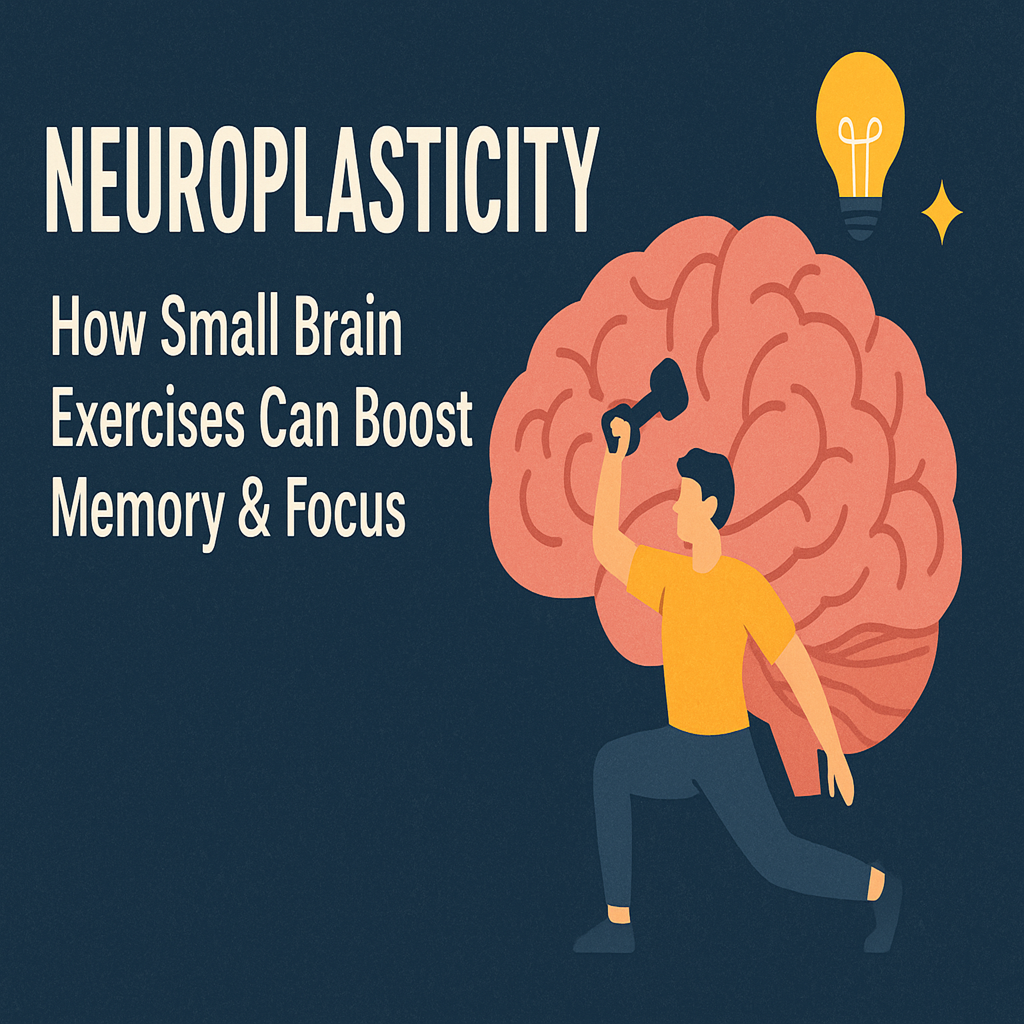
Neuroplasticity: How Small Brain Exercises Can Boost Memory & Focus
The human brain is not a rigid machine fixed at birth; instead, it is a living, evolving organ that continually adapts to new experiences. This incredible adaptability is calledneuroplasticity. For centuries, scientists believed that the brain stopped developing once a person reached adulthood. However, modern neuroscience has revealed a different reality—our brains remain flexible throughout life.
This means that with the right exercises and habits, people can improve memory, sharpen focus, and even repair cognitive damage.From learning a new language to practicing mindfulness, small brain exercises can reshape the way neurons connect, creating stronger mental pathways. In today’s world, where distractions are everywhere and mental fatigue is common, understanding neuroplasticity is more important than ever.
What Is Neuroplasticity?
The word neuroplasticity comes from two roots:
- Neuro – meaning “nervous system” or “brain.”
- Plasticity – meaning “malleability” or “ability to be shaped.””
Together, neuroplasticity refers to the brain’s capacity to reorganize itself by forming new neural connections. Every thought, emotion, and action involves communication between billions of neurons. When a behavior is repeated, those neural pathways grow stronger, much like a muscle becoming toned with regular exercise.
This is why habits, whether good or bad, become “wired” into the brain. The good news is that the brain can always form new pathways, allowing us to break old patterns and build new skills.
Learn more about Therapeutic Interventions and how can How to heal your past life trauma?
Types of Neuroplasticity
1. Functional Neuroplasticity
- The brain’s ability to transfer functions from a damaged area to a healthy one.
- For example, after a stroke, some people regain speech by training different brain regions to take over language processing.
2. Structural Neuroplasticity
- The brain’s ability to physically change its structure in response to learning and experience.
- Studies show that London taxi drivers, who memorize thousands of streets, have larger hippocampi—the brain region linked to memory.
3. Synaptic Neuroplasticity
- Changes at the level of synapses (connections between neurons).
- Strengthening or weakening of synapses directly affects memory and learning efficiency.
Brain Exercises That Boost Memory & Focus
1. Mindful Meditation
- Trains attention and reduces mental clutter.
- MRI studies show that meditation thickens the prefrontal cortex, which is responsible for decision-making and focus.
- Even 10 minutes a day can improve working memory.
Practical tip: Focus on your breathing, notice thoughts without judgment, and bring your attention back whenever it wanders.
2. Learning a New Skill
- Activities like playing an instrument, learning a new language, or even cooking a new recipe challenge the brain.
- These skills create new neural connections and strengthen memory pathways.
Practical tip: Choose something enjoyable but outside your comfort zone—it should feel like a stretch, not a chore.
3. Brain Games & Puzzles
- Crosswords, Sudoku, chess, or memory games stimulate problem-solving areas.
- Regular practice improves working memory and processing speed.
Practical tip: Dedicate 15–20 minutes daily to puzzles or logic games.
4. Physical Exercise
- Movement increases blood flow and oxygen to the brain, enhancing neurogenesis (growth of new neurons).
- Aerobic exercises like running or swimming improve focus and reduce brain aging.
Practical tip: Just 30 minutes of brisk walking 5 days a week can improve both physical and mental health.
5. Visualization Exercises
- Visualizing an action (like practicing a sport in your mind) activates similar brain regions as physical practice.
- Helps with memory recall and concentration.
Practical tip: Before a presentation, visualize yourself speaking confidently and recall your points.
6. Memory Recall Practice
- Instead of rereading notes, test yourself by recalling information.
- This strengthens synaptic connections and improves long-term memory.
Practical tip: At the end of each day, recall three new things you learned, without looking at notes.
7. Mindful Screen Use
- Since excessive screen time reduces focus, deliberate breaks train attention.
- The “Pomodoro technique” (25 minutes of focused work, 5 minutes break) is highly effective.
Practical tip: Use apps that block distracting notifications during focus periods.
The Role of Nutrition in Neuroplasticity
A brain exercise routine must be supported by proper nutrition. Certain foods and nutrients promote neural growth:
- Omega-3 Fatty Acids – Found in salmon, walnuts, chia seeds. Boost memory and neuron repair.
- Antioxidants – Blueberries, green tea, and dark chocolate protect neurons from oxidative stress.
- B Vitamins – Essential for neurotransmitter production.
- Hydration – Even mild dehydration can impair focus and memory.
Sleep: The Forgotten Brain Exercise
Sleep is the most underrated brain booster. During deep sleep:
- The brain consolidates memories, transferring them from short-term to long-term storage.
- Neural waste is cleared through the glymphatic system.
- REM sleep enhances problem-solving and creativity.
Practical tip: Aim for 7–9 hours of quality sleep, avoid screens before bed, and create a calming sleep environment.
Real-Life Evidence of Neuroplasticity
1. Stroke Recovery
- Patients relearn lost functions like speech and movement through targeted brain training.
2. Children with Learning Disabilities
- Specialized exercises strengthen reading and memory skills, showing measurable brain changes.
3. Elderly Adults
- Studies show that seniors who engage in puzzles, social activities, and exercise maintain sharper memory longer.
The Psychological Benefits of Brain Exercises
Neuroplasticity doesn’t just boost memory and focus—it also improves emotional well-being.
- Resilience – Training the brain builds coping strategies for stress.
- Reduced Anxiety & Depression – Mindfulness and exercise promote neurotransmitters like serotonin and dopamine.
- Increased Confidence – Mastering new skills enhances self-esteem.
Small Habits, Big Changes
The beauty of neuroplasticity lies in its accessibility. You don’t need expensive tools or radical lifestyle changes. By adding micro-habits into daily life, anyone can improve memory and focus. Examples include:
- Reading instead of scrolling before bed.
- Practicing gratitude journaling for 5 minutes daily.
- Taking the stairs instead of the elevator.
- Learning one new word or fact every day.
These small actions compound into lasting cognitive growth.
Conclusion
The science of neuroplasticity proves that the brain is never static—it is always ready to grow, adapt, and evolve. Memory lapses, poor focus, and mental fatigue are not permanent conditions; they are signals that the brain needs exercise.
Through mindfulness, learning, puzzles, physical activity, visualization, proper nutrition, and good sleep, anyone can unlock the brain’s full potential.
In a world filled with stress, distractions, and sleepless nights, embracing neuroplasticity is like giving your mind a powerful reset button. By practicing small, consistent brain exercises, you can sharpen memory, deepen focus, and improve overall well-being.
The truth is simple yet profound:myour brain is always changing—why not guide that change toward clarity, resilience, and brilliance?

